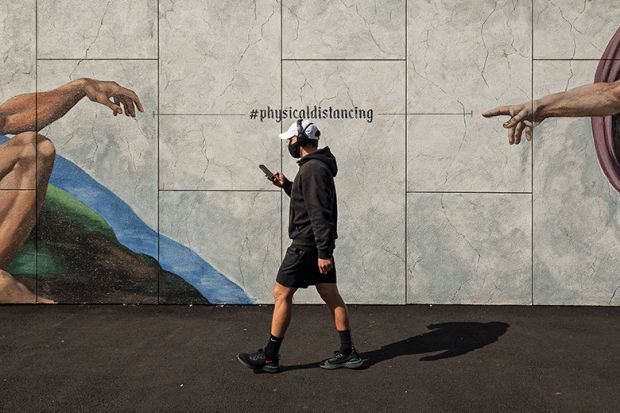Face-to-face lectures are unlikely to return to growing numbers of Australian campuses once Covid-19 has been vanquished, raising questions about whether the pandemic will have a decisive impact globally on the long-running debate about the future of large-group teaching.
Perth’s Curtin University proposes to scrap all lectures by the end of this year, starting with those involving 100 people or more. They will be replaced by “CurtinTalks” – short videos of 10 to 15 minutes, each based on a single topic or concept, with students expected to watch two or three a week for each subject.
Nearby Murdoch University has similar ideas, with Kylie Readman, the pro vice-chancellor (education), giving teaching staff 18 months to “transition away” from lectures. “We are not going to be having large-scale face-to-face lectures any more,” she told Times Higher Education.
Instead, information previously delivered through lectures will be curated, squeezed into “mini lectures” and integrated with online activities. Whatever online lectures remain will be timetabled, recorded and broadcast in a “synchronous” mode that allows for interactions between students.
Strategies for scaling up quality online courses in higher education
Like Curtin, Murdoch is still consulting staff over the changes.
Universities elsewhere are thinking along similar lines, after being forced to switch to online learning under social distancing restrictions. Many have found that small-group seminars have translated better to this model than lectures.
Recently installed University of Leeds vice-chancellor Simone Buitendijk plans to replace long-form lectures with “shorter chunks” that students can watch before class to pre-arm themselves with the knowledge they need to “become more creative and engaged with their teaching”. Professor Buitendijk told THE previously that long-form lectures were “pedagogically not sound” and not evidence-based, and that the change would have happened regardless of Covid.
Monash University vice-chancellor Margaret Gardner said such discussions were “particularly advanced” at Australian universities, partly because of their scale. She said there was a “big difference” between classes of 50 and the 1,000-student units common at many Australian institutions.
“Australia’s tested how you innovate in these circumstances,” she said. “It’s not that all lectures will disappear, but the notion that they are the key to education is gone – all of us understand that. They are going to happen less frequently and they are going to be more considered for what they’re offering that you can’t get some other way.”
Melbourne-based Victoria University says there is no place for lectures in its “block teaching” model, which is based around small class groups. Trish McCluskey, its associate provost of learning and teaching, said lectures were “an artefact of a bygone era”, when books and resources were scarce and the only way to learn was to sit at scholars’ feet.
How to go about ‘chunking’ online lectures to get the best results from students
“Lectures were the transmission of information from the lecturer’s head through the pen of the student and on to the exam paper. It never actually made it into the student’s head.”
Ms McCluskey said some lecturers were strong storytellers, but the format was too long. Presentations of 15 to 20 minutes, the typical duration of a TED Talk, were superior because “that’s the amount of time that students are known to be able to concentrate for”.
Neil Morris, Leeds’ interim deputy vice-chancellor for digital transformation, said universities worldwide were reviewing which parts of their coronavirus response to retain in teaching long-term.
“There will always be a place for the performance, community feeling and impact of a good lecture for stimulating, inspiring and conveying new knowledge, and these will return. However, I think they will be reduced in number, as some lectures will be replaced with more online pre-recorded content and use of class time for small-group problem solving and creativity,” Professor Morris said.
“I predict a future where the proportion of large-class ‘didactic, lecture-style’ events will be reduced to around 20 per cent of the contact time for students in a taught module – from the current average of around 80 per cent – with the difference being replaced by more small-group interactive problem-based classes, supported by digital technology and online content.”
But Graham Virgo, senior pro vice-chancellor for education at the University of Cambridge, said that while some disciplines may make greater use of the flipped classroom model, many students and academics felt that recorded footage “cannot replicate the high-quality in-person lecture”.
“It is the responses from students in particular who have wanted the residential experience and who miss attending lectures which means that it is important that we tread carefully and do not throw out the baby with the bathwater,” he said. “The obituary for the in-person lecture would be premature.”
POSTSCRIPT:
Print headline: Australian campuses to drop lectures post-Covid
Register to continue
Why register?
- Registration is free and only takes a moment
- Once registered, you can read 3 articles a month
- Sign up for our newsletter
Subscribe
Or subscribe for unlimited access to:
- Unlimited access to news, views, insights & reviews
- Digital editions
- Digital access to THE’s university and college rankings analysis
Already registered or a current subscriber? Login










